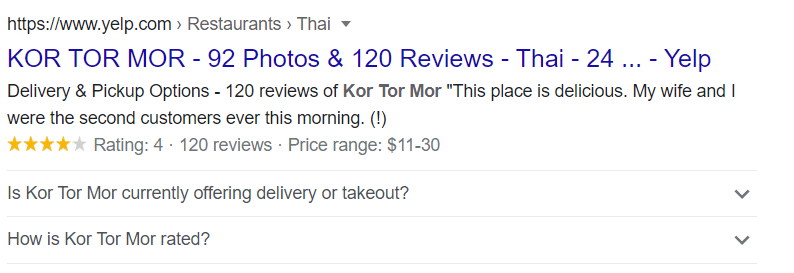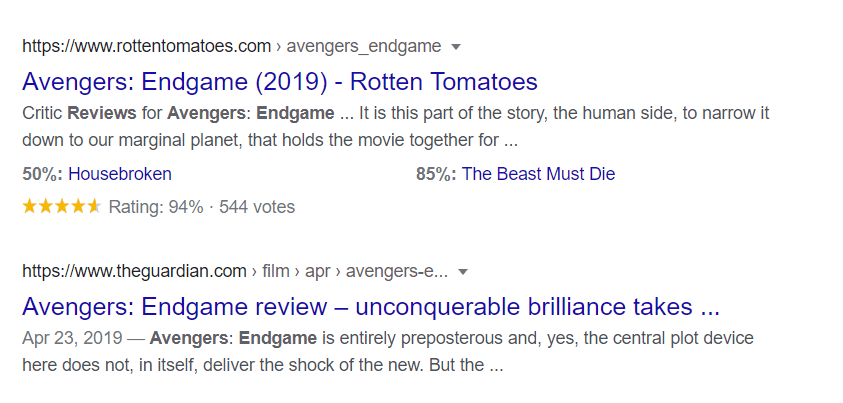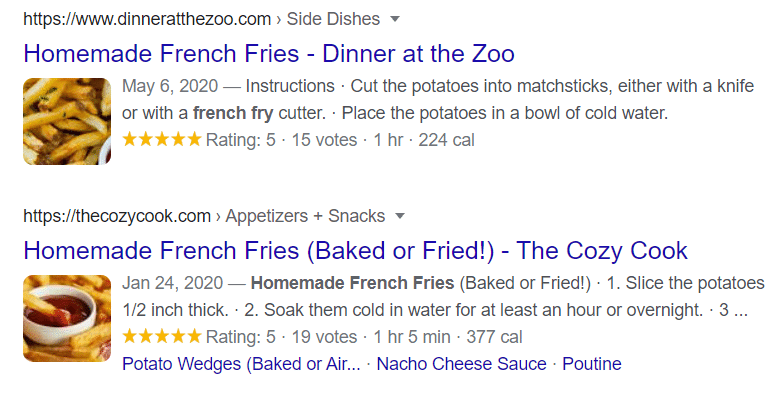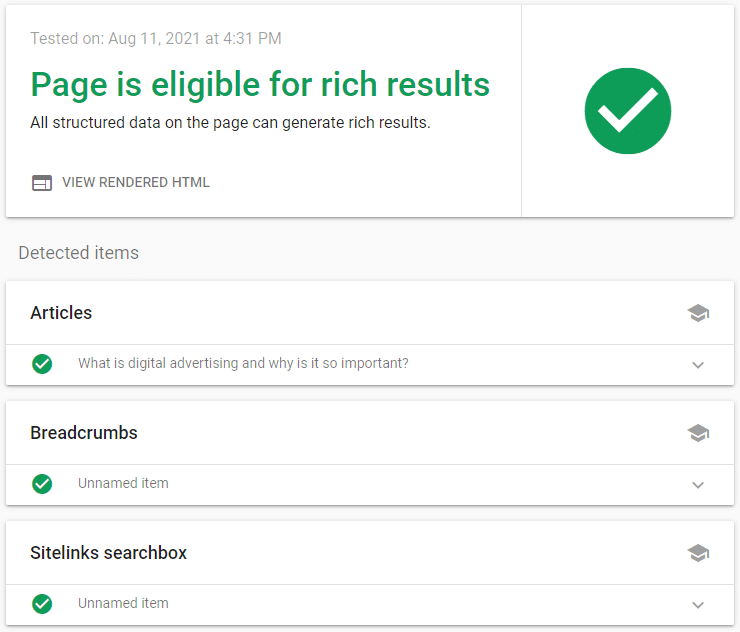Finding your own space in Search Engine Result Pages (SERPs) is a battle for attention.
With so many link options, any additional information, visual hook, or extra details are decisive in helping the user choose where to click.
That is why getting rich snippets is such an important goal for SEO right now.
Brands that can get Google to feature their pages have a huge boost in visibility, lead attraction, and overall website traffic.
But what are these special search results and how do you get some of them for your business?
In this post, we will define rich snippets and discuss their importance. Then, we will give you some examples of rich snippets.
What are Rich Snippets?
When Google and other search engines started automating indexation, there was a more even approach to how results were displayed.
Basically, the most useful and relevant links would appear first, but the order was the only ranking factor.
The amount of information, layout, and the number of words were all equal for every result.
That changed with time when these companies invested more in user experience.
They realized that to ease the user’s effort to find the information they want, it was necessary to give more context to the SERPs — and so, organizing it in a way that is more accessible, intuitive, and objective.
For Google, this led to snippets: results that are displayed first when the user searches for something, giving special information like direct answers and definitions, and showing images and other extra content.
The rich snippet is one of those special results with additional data displayed.
In the image below, for example, you can see the rating of the restaurant, as well as the price range for the dishes.

To do that, Google pulls from the page’s HTML the structured data it considers useful for a better overview of its content.
It can be a movie review score, the time it takes to do a recipe, or a photo of the product you are talking about.
That is why getting rich snippets is a marriage between good content and good structure.
It’s an effort to plan and create blog posts, articles, and even product pages with a specific goal in mind.
But we will talk more about it later.
Are Rich Snippets Good for SEO?
It isn’t hard to imagine that having your webpage featured with rich snippets results in consistent gains for organic traffic.
It is what studies show regularly, pointing to overall growth in most kinds of content.
But let’s try to understand this importance a little better.
Rich snippets help SEO both from a more direct approach — boosting page visibility — and for the greater role of building authority and making your brand well-known.
The direct effect of rich snippets on SEO
When your page is featured with a rich snippet, it displays more info than your average search result.
Just that fact alone is enough to grab the user’s attention and make your content stand out.

When searching for something on Google, the user usually has a goal. They start with a question and want answers quickly.
What a rich snippet provides is the extra data necessary to decide if that link will provide them what they need — without having to go back and forth down the SERP.
It is important to have that in mind because some Chief Marketing Officers (CMOs) have an incorrect understanding of what a rich or a featured snippet can do.
They think giving up information on the results page will stop the user from visiting the website.
That is not even close to the truth — at least in most cases.
What a rich snippet does is build trust and guarantee that your content has what the user needs. With that assurance, it will always be the preferred choice for their first click.
The strategic effect of rich snippets on SEO
When a page has a rich snippet, it gets more organic traffic. There is no way to be more direct than this.
But what does this effort do to improve your visibility on SERPs on a grander scale? What about your Digital Marketing strategy?
SEO is a lot about building an image.
When a company is consistently presented as useful and relevant for the public’s queries, it slowly becomes recognized as a brand that customers can trust.
If that image sticks, your content is chosen more often among other results and a virtuous cycle begins.
So, even if not all users are clicking on your rich snippets, the more you have of them the more it shows up on the top of different result pages.
The extra information is available right there before anyone else, so the Google page itself becomes a place to consume your content.
With time, with more and more rich snippets, you can build a solid presence on SERP based on the keywords that are relevant for your business.
For a Digital Marketing plan, it is the best place to be: getting organic traffic with low investment and diversifying your lead-generating channels.
Rich Snippets Examples
The kind of rich snippet you get depends on the type of content it refers to.
So, it is important to know what you can do with this feature so you plan your posts and pages accordingly.
Let’s take a look at some examples of specific-aimed snippets and how they are displayed on a SERP.
Recipes

When searching for a recipe, the user needs some information other than just the title and description.
A rich snippet offers a photo of the dish, time of preparation, ratings, calories, and other relevant data.
Movies

Likewise, when searching for movies, some information will instantly inform the user who may be curious to go deeper into some of that data — especially film enthusiasts.
Google can show details like runtime, release date, box office, genre, and ratings.
Music

A music snippet behaves in the same way, showing rich data like credits for composition and songwriting, year of publishing, and relevant links for different versions and interpretations.
Products

For those investing in SEO for e-commerce and digital products, the rich snippet for products is a great way of improving visibility.
They can show not only a description of it but also info on ratings, price, availability, and direct links to different Stock Keeping Units (SKUs).
Events

For events, rich snippets show relevant information about past and future editions. Details such as attendance, location, schedule, and even extra links for buying tickets could be included.
How Do You Get Rich Snippets?
The decision of whether a search result will or won’t be featured as a rich snippet is entirely up to Google.
➤ What a CMO can do then is to create a solid strategy and structure for the content that will make it look more relevant and snippet-ready.
The more you think about these points and put them into practice in your campaign’s routine, the more chances you have to display rich information throughout different searches.
So let’s talk about how you can enable your content to stand out more with time — naturally improving your SEO.
Know your content
Content planning is a crucial part of a CMO’s job in the digital field — as it will be the main source of interaction between the brand and its leads.
But, more than that, here it becomes a technical point of interest.
To be featured as a rich snippet, Google has to recognize the link as one of the categories above.
So, first of all, you can look back at what you have planned for your blog and web pages and find opportunities to bring out content that fits that criteria.
It is possible to adapt some old and new posts or even create a new strategy within the campaign, focused solely on getting those snippets.
Know your buyer persona
Your content needs to be not only technically right for a rich snippet but also relevant to those searching for the keywords you are trying to rank on.
It seems obvious, right? Maybe it is.
But so many SEO plans fall short because of a bad understanding of the buyer persona that this advice needs to be restated.
Understanding your customer is not only about knowing data points such as age, gender or class.
It is even more important to know their habits, expectations, and ways of interaction with a brand.
In this case, understanding how they do searches on the internet and what kind of content makes them click a link is vital to your success.
Learn more about structured data
You know what to write and the intended audience, so now what? How can Google identify your content as snippet-ready?
To do that, you will need to know more about structured data.
Structured data is a set of HTML and JSON-LD standards that Google crawlers use to read, understand and display your webpages on a SERP.
As this part is technical and demands the content creator to follow some specific guidelines, we won’t be venturing into details here.
But we strongly recommend that you go to Google Search Central and learn more about structured data.
To put these guidelines into practice, Schema.org is the most used vocabulary, so you must check their website as well to start planning your new content.
Build content around snippets
Now that you have a strategy, a better understanding of your buyer persona, and you know what you have to do to create structured data, your team is ready to build the right content for rich snippets.
The main priority should be getting straight to the point.
As you could see in our examples, snippets offer direct, informative data. If your content is not tightly related to that info, users can bounce back and your SEO is harmed.
After that, you should guarantee the content goes beyond what the snippets show, providing depth and leading to other points of interaction with your brand.
After all, if you get a rich snippet, you will surely get more traffic. Not having a follow-up for the content itself would be a waste.
Test your structure
After your content is ready and structured, you can use Google’s own testing tool to see if it has everything it needs to be featured as a rich snippet.
It is really important to do that even before posting (you can paste the content’s code), so you are sure that it is eligible from the start when it gets more attention and clicks.

Monitor results
Like any other SEO effort, your job is not nearly finished when you hit publish.
A healthy strategy needs to follow results constantly, learn with them, and apply improvements based on them in the future.
So it is time to monitor which of your planned content gets featured as rich snippets and what their impact is on overall visibility.
Try to go deep into the data to find out what worked and why.
Use that knowledge to rearrange existing content and to create new content.
If this becomes a routine in your SEO campaign, the results come stronger and faster with time. Each new success appearing on the top of SERPs is a new huge channel for leads acquisition.
Wrap Up: Where Do I Go From Here?
In the digital field, getting visibility and recognition for your brand is not a small task.
It demands planning, studying, monitoring, and learning. But, when you are successful, it is worth more than any other kind of marketing strategy today.
A great SEO effort, one that puts your brand at the top of search results and displays extra details like rich snippets, allows a company to attract and convert organically, without having to spend more of your budget and time.
If you know the paths, know your public, and own your content, you are halfway there.
But how strong is your strategy right now?
If you want to build your future, you need to be aware of your present.
To do that, check this SEO maturity assessment and start focusing on what really matters to grow!




![[ROCK NA] [EBOOK SEO] Complete Guide](https://rockcontent.com/wp-content/uploads/2024/06/banner_Search-Engine-Optimization.png)






